Ondine Label Sale Spring 2024
414 products
-

-

-
 {# optional: put hover video/second image here positioned absolute; inset:0 #}
On SaleOndine
{# optional: put hover video/second image here positioned absolute; inset:0 #}
On SaleOndineKõrvits: The Sound of Wings / Joost, Tallinn Chamber Orchestra
Estonian composer Tõnu Kõrvits (b. 1969) belongs to his country’s most prominent composers. His works are rich with delicate atmosphere possessing a...
June 02, 2023$18.99$9.49 -

-

-
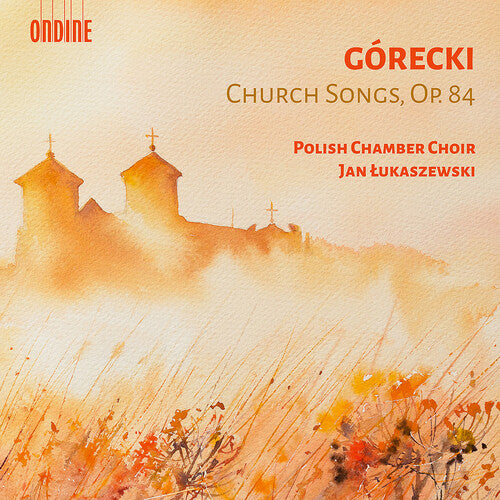 {# optional: put hover video/second image here positioned absolute; inset:0 #}
On SaleOndine
{# optional: put hover video/second image here positioned absolute; inset:0 #}
On SaleOndineGórecki: Church Songs, Op. 84 / Łukaszewski, Polish Chamber Choir
Henryk Mikolaj Górecki (1933–2010) achieved an international success in the mid-1990s, with his Symphony No. 3, “Symphony of Sorrowful Songs”. Since then,...
May 05, 2023$26.99$20.99 -

-
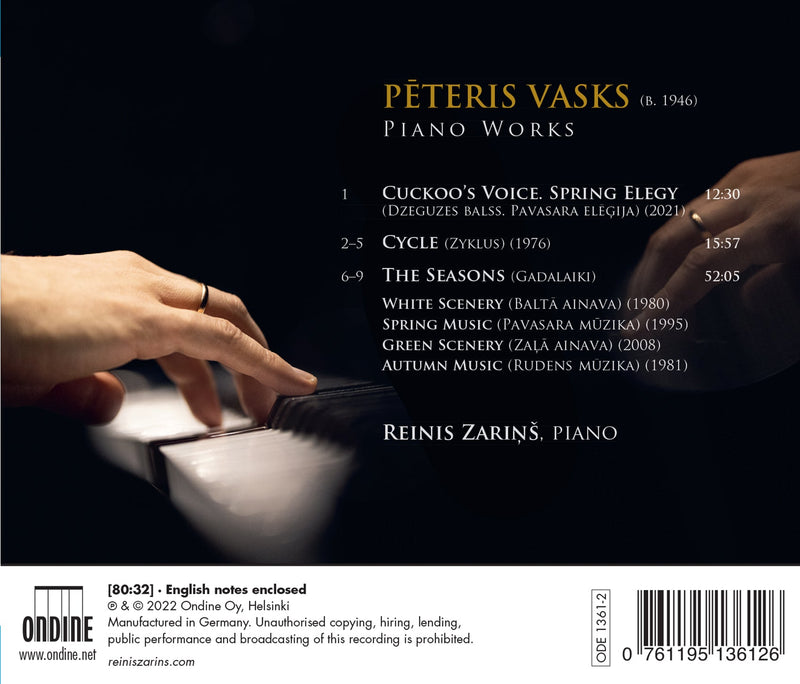
-
 {# optional: put hover video/second image here positioned absolute; inset:0 #}
On SaleOndine
{# optional: put hover video/second image here positioned absolute; inset:0 #}
On SaleOndineVasks: Piano Works / Reinis Zarinš
The love for the Latvian landscape is audible in the piano works of Latvia’s greatest living composer, Peteris Vasks (b. 1946), especially...
May 06, 2022$18.99$9.49 -

-

-
 {# optional: put hover video/second image here positioned absolute; inset:0 #}
On SaleOndine
{# optional: put hover video/second image here positioned absolute; inset:0 #}
On SaleOndineBruckner: Latin Motets / Kļava, Latvian Radio Choir
Ondine is proud to release its 17th album together with the award-winning Latvian Radio Choir and conductor Sigvards Kļava dedicated to a...
November 06, 2020$18.99$14.99 -

-

-
 {# optional: put hover video/second image here positioned absolute; inset:0 #}
On SaleOndine
{# optional: put hover video/second image here positioned absolute; inset:0 #}
On SaleOndineKõrvits: You Are Light And Morning / Joost, Tallinn Chamber Orchestra
This new album by the award-winning Estonian Philharmonic Chamber Choir together with Tallinn Chamber Orchestra led by Risto Joost includes one of...
October 02, 2020$18.99$14.99 -

-

-
 {# optional: put hover video/second image here positioned absolute; inset:0 #}
Ondine
{# optional: put hover video/second image here positioned absolute; inset:0 #}
OndineNørgard & Ruders: Works for Solo Cello / Wilhelmina Smith
Cellist Wilhelmina Smith’s second album release on Ondine continues exploring contemporary Nordic repertoire for solo cello. In her new album Smith has...
$18.99January 08, 2021 -

-

-
 {# optional: put hover video/second image here positioned absolute; inset:0 #}
Ondine
{# optional: put hover video/second image here positioned absolute; inset:0 #}
OndineBacewicz: Piano Works / Peter Jablonski
On this album, Peter Jablonski’s third for Ondine, the pianist presents Grażyna Bacewicz’s (1909–1969) dazzling piano etudes and sonatas, barely known outside...
$18.99February 04, 2022 -

-

-
 {# optional: put hover video/second image here positioned absolute; inset:0 #}
On SaleOndine
{# optional: put hover video/second image here positioned absolute; inset:0 #}
On SaleOndineChopin: Complete Mazurkas, Vol. 1 / Jablonski
Internationally acclaimed Swedish pianist Peter Jablonski is known as a fervent champion of Polish music. In this album Jablonski returns to some...
October 07, 2022$18.99$9.49 -
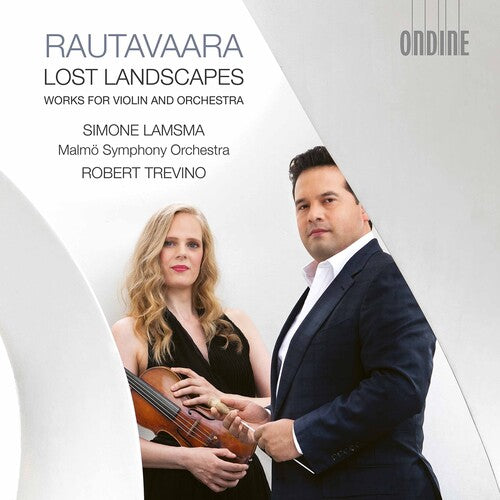
-
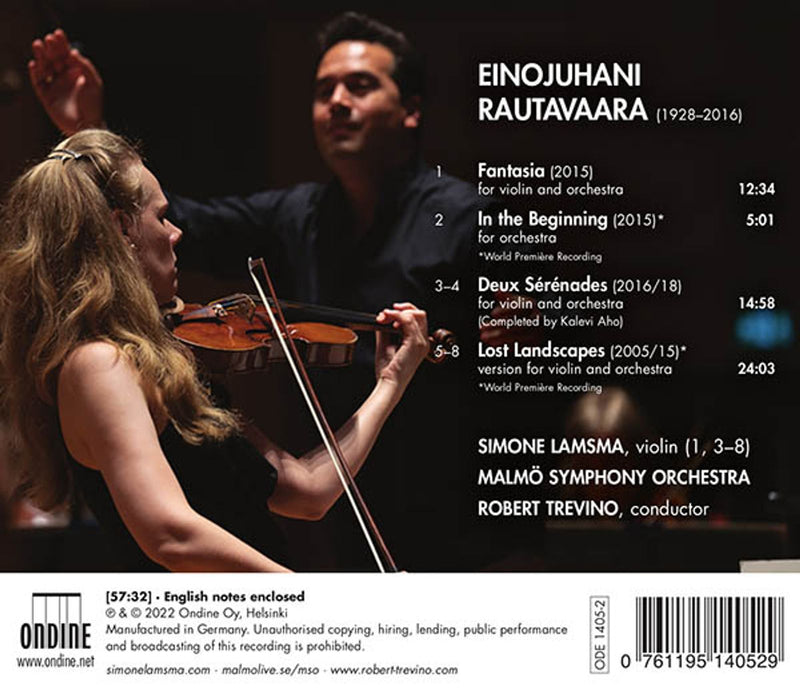
-
 {# optional: put hover video/second image here positioned absolute; inset:0 #}
On SaleOndine
{# optional: put hover video/second image here positioned absolute; inset:0 #}
On SaleOndineRautavaara: Lost Landscapes / Lamsma, Trevino, Malmö Symphony Orchestra
Conductor Robert Trevino’s fourth album release on Ondine is focused on the late works of composer Einojuhani Rautavaara (1928–2016), one of Finland’s...
April 01, 2022$18.99$9.49 -

-

-
 {# optional: put hover video/second image here positioned absolute; inset:0 #}
Ondine
{# optional: put hover video/second image here positioned absolute; inset:0 #}
OndineMartinaitytė: Ex Tenebris Lux / Giunter, Vaitkevičius, Variakojis, Lithuanian Chamber Orchestra
This second Ondine recording of music by Žibuoklė Martinaitytė (b. 1973) is devoted exclusively to works scored for string orchestra, all of...
$18.99June 03, 2022 -

-

-
 {# optional: put hover video/second image here positioned absolute; inset:0 #}
On SaleOndine
{# optional: put hover video/second image here positioned absolute; inset:0 #}
On SaleOndineCage: Choral Works / Kļava, Latvian Radio Choir
This new album release by the Latvian Radio Choir and conductor Sigvards Kļava on Ondine is devoted to choral works by the...
July 15, 2022$18.99$14.99 -
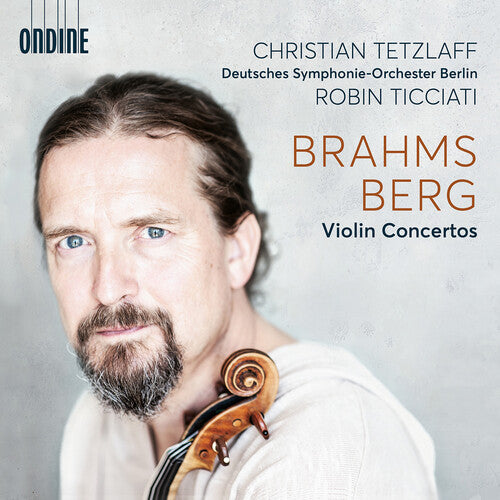
-
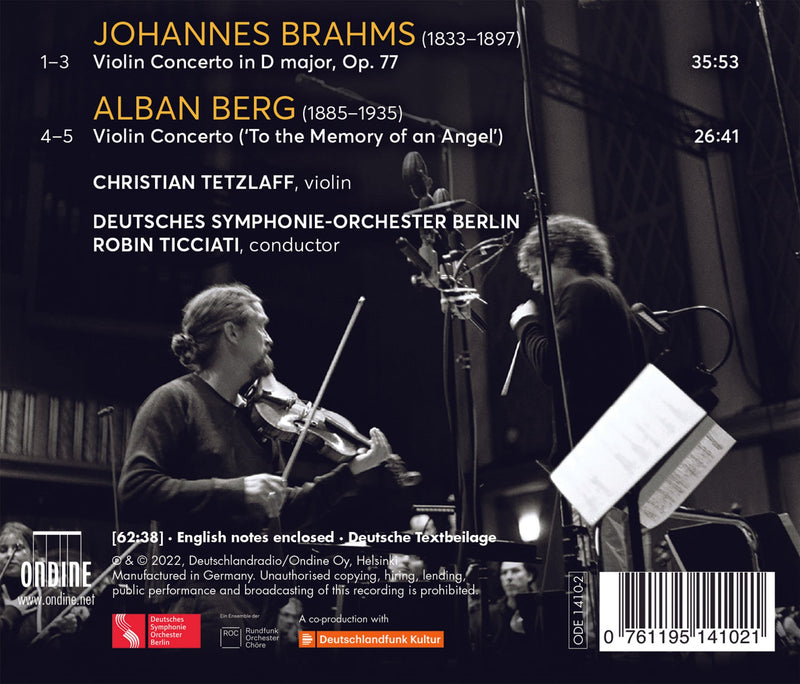
-
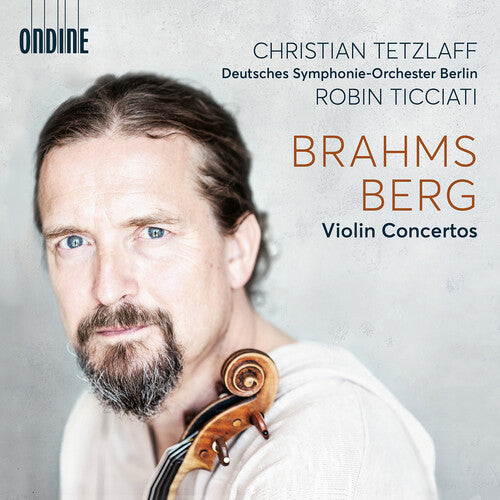 {# optional: put hover video/second image here positioned absolute; inset:0 #}
On SaleOndine
{# optional: put hover video/second image here positioned absolute; inset:0 #}
On SaleOndineBrahms & Berg: Violin Concertos / Tetzlaff, Ticciati, German Symphony Orchestra Berlin
In this new concerto album one of the greatest violinists of his generation, Christian Tetzlaff, offers profound interpretations of two deeply dramatic...
September 02, 2022$18.99$9.49 -
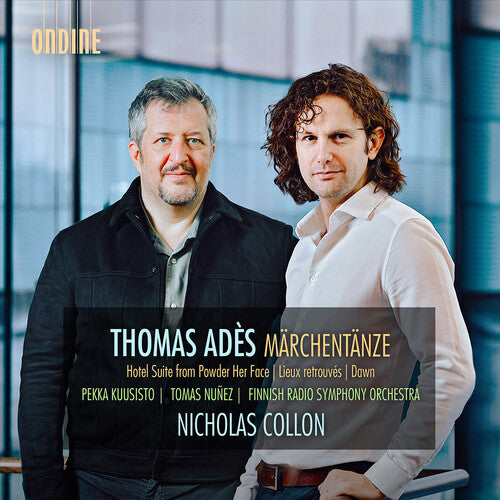
-
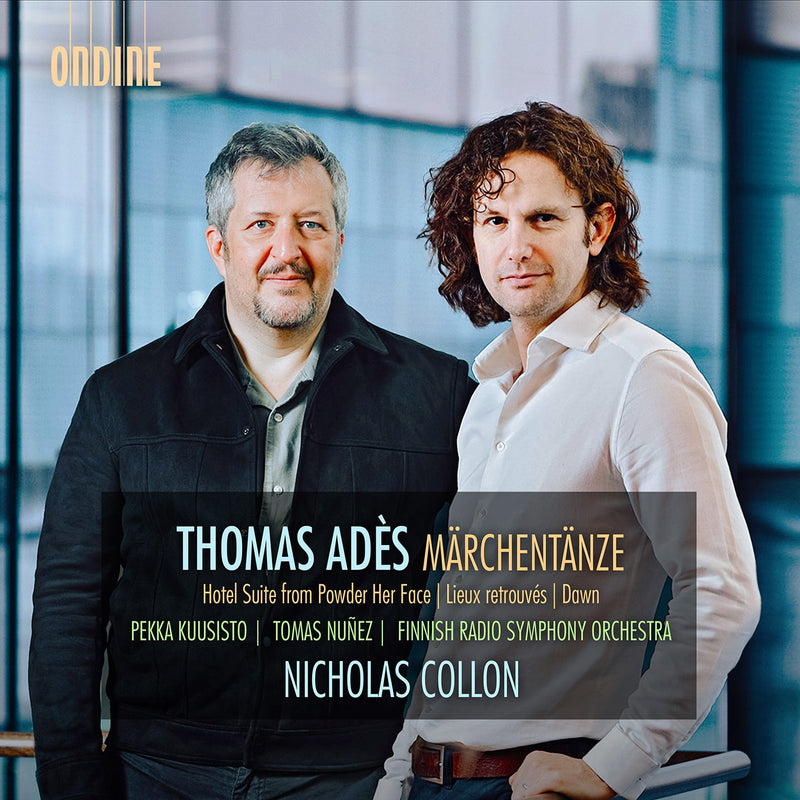
-
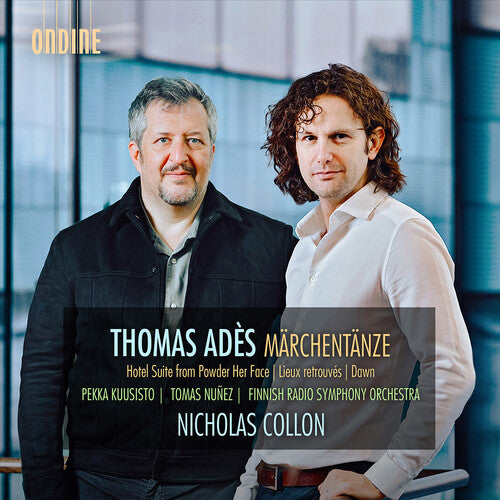 {# optional: put hover video/second image here positioned absolute; inset:0 #}
On SaleOndine
{# optional: put hover video/second image here positioned absolute; inset:0 #}
On SaleOndineAdès: Märchentänze & Other World Premieres / Kuusisto, Nuñez, Collon, Finnish RSO
In the Autumn of 2021, the Finnish Radio Symphony Orchestra together with its new chief conductor, Nicholas Collon, arranged a Thomas Adès...
October 07, 2022$18.99$9.49 -

-

-
 {# optional: put hover video/second image here positioned absolute; inset:0 #}
On SaleOndine
{# optional: put hover video/second image here positioned absolute; inset:0 #}
On SaleOndineRavel: Orchestral Works, Vol. 2 / Trevino, Basque National Orchestra
Robert Trevino’s first album together the Basque National Orchestra featuring orchestral works by the great French-Basque composer Maurice Ravel (1875–1937) received an...
November 04, 2022$18.99$9.49 -

-

-
 {# optional: put hover video/second image here positioned absolute; inset:0 #}
Ondine
{# optional: put hover video/second image here positioned absolute; inset:0 #}
OndineKeninš: Symphonies Nos. 5 & 8; Aria / Apkalna, Latvian National Symphony
Andris Poga and the Latvian National Symphony Orchestra plunge into Keninš’ challenging idiom with a vengeance, turning in bracing, invigorating performances of...
$18.99February 04, 2022
Kõrvits: The Sound of Wings / Joost, Tallinn Chamber Orchestra
Estonian composer Tõnu Kõrvits (b. 1969) belongs to his country’s most prominent composers. His works are rich with delicate atmosphere possessing a particularly Northern feel combined with a romantic and Impressionistic touch. This new album by the award-winning Estonian Philharmonic Chamber Choir, Tallinn Chamber Orchestra and conductor Risto Joost is the final volume in a trilogy of works for choir and orchestra. Moorland Elegies (ODE 1306-2), You Are Light and Morning (ODE 1363-2) and The Sound of Wings form a kind of a trilogy, albeit this was never a purpose in itself. All three works were performed first by the Estonian Philharmonic Chamber Choir and Tallinn Chamber Orchestra, conducted by Risto Joost. The first two cycles are linked to the elements of earth and water. In this final part of the trilogy everything is carried by the element of air, and those existential themes which Tõnu Kõrvits has dealt with for decades in his works – nature, life, death, suffering, love – find a liberating and soaring solution. The composer has said that it is “the brightest work in the trilogy (...), which emanates the most light. It is a song of flying, of dreaming, of courage and unconditional love.”
One of the sources of inspiration for The Sound of Wings was Amelia Mary Earhart’s attempt to be the first woman in aviation history to fly around the globe together with navigator Fred Noonan, which was cut short whilst crossing the Pacific Ocean. On her specially adapted red Lockheed Model 10-E Electra, Earhart was supposed to make a last land stop on Howland Island, but due to a fault in the navigation system she was unable to find it. Neither Earhart or the remains of her plane have ever been found. Earhart’s last radio transmission – inspiring due to the steadiness and matter-of-factness of the pilot’s voice – gave the titles to the two instrumental parts of the work. The element of air, the wind, the emptiness, flight and liberation in the music are embodied by the solo viola. The flageolet passages of the solo viola, the trills, the motifs which sway up and down pass through the entire piece, introducing as well as completing it. Wind images painted through sound can also be found in the orchestra and choir parts. Kõrvits’ instrumentation is sensitive and imaginative, just like his extraordinary talent of using the choir in the most varied but always singing way.
REVIEW:
Tonu Korvits (b 1969) is possibly the most prominent Estonian composer of his generation, known particularly for his choral music. His music is lyrical and firmly tonal, though smooth, bluesy chromatic tones give it an elusive, hypnotic quality. He writes with genuine beauty, finding a kind of magic in tonality that is all too rare these days.
The Sound of Wings (2022) concerns Amelia Earhart. The text doesn’t so much follow a narrative but rather a succession of abstract meditations on emotions, aspirations, and sensations she might have felt while in the air. A solo viola evokes the ephemeral but liberating qualities of air with harmonics; it reaches its apex in a full-blooded solo in the last movement. The choral writing is consistently tender and lyrical, with attentive, natural text-setting. It is slow and often reserved, but always interesting and often quite moving. We also get the short but achingly beautiful ‘Sunday Wish’ (2020/22).
Wonderful performances from the Estonian Philharmonic Chamber Choir and Tallinn Chamber Orchestra, under the direction of Risto Joost. The choir is particularly exceptional, singing with a consistently gorgeous tone. Notes and text in Estonian and English.
-- American Record Guide
Górecki: Church Songs, Op. 84 / Łukaszewski, Polish Chamber Choir
Henryk Mikolaj Górecki (1933–2010) achieved an international success in the mid-1990s, with his Symphony No. 3, “Symphony of Sorrowful Songs”. Since then, Górecki’s name has been associated almost exclusively with this piece. However, his music is much more than this one brilliant work. Górecki never looked at musical fashions, but consistently created his own sound universe. In the 1980s Górecki, feeling misunderstood, stepped back from the official concert life in Poland. He reached out to simple folk and church melodies, making their choral arrangements. He treated them with a great devotion and humility. In 1985, the composer drew on traditional church songs collected in the 19th-century Spiewnik koscielny (Church Songbook) by Jan Siedlecki. He first selected five songs from it, which made up the cycle of five Marian Songs, Op. 54, for mixed choir a cappella. A year later, Górecki decided to compile other church songs of various character and associated with different liturgical seasons. This led to a collection of twenty Church Songs for a cappella choir today known as his Op. 84. Apart from two, the songs were not published during composer’s lifetime. This album by the Polish Chamber Choir led by Jan Lukaszewski offers this choral gem for the first time sang in Latin.
REVIEW:
Mostly dating from 1986 but published in 2013, three years after the composer’s death, these 20 pieces range from between one and almost 13 minutes in duration. Recorded in Latin for the first time, they have a consoling lilt and occasionally (as in ‘Sicut parvi amplectamur’) dance along gently; ‘Beati qui eligunt Joseph’ is a rare example of a more striking harmonic treatment. Under its conductor of 40 years’ standing, Jan Łukaszewski, the Gdańsk-based Polish Chamber Choir produces beautifully smooth and glowing tone. The overall effect is sweet, like eating too much sernik (Polish cheesecake) and washing it down with communion wine.
-- BBC Music Magazine
Vasks: Piano Works / Reinis Zarinš
The love for the Latvian landscape is audible in the piano works of Latvia’s greatest living composer, Peteris Vasks (b. 1946), especially in his Seasons, the composer’s most frequently performed piano work. For this album pianist Reinis Zarinš has brought two other piano works alongside The Seasons as first recordings: Vasks’ early piano work Cycle (Zyklus) from the 1970s, and a new piano work, Cuckoo’s Voice. Spring Elegy (2021), written by the composer for Reinis Zarinš during the pandemic.
Ever since his concerto debut at the age of ten, Reinis Zariņš has performed as a concerto soloist, recitalist, and chamber musician throughout Europe and North America. He has participated in prestigious music festivals including the Lucerne Festival, the Bath International Music Festival, and the Scotia Festival of Music. His thoughtful virtuosity has delighted audiences at Amsterdam’s Concertgebouw, London’s Wigmore Hall, New York’s Weill Recital Hall at Carnegie Hall, and the Tchaikovsky Concert Hall in Moscow. Reinis has collaborated with leading orchestras including the London Philharmonic Orchestra, the Moscow Chamber Orchestra, Kremerata Baltica, and the Ostrobothnian Chamber Orchestra, and with conductors Pierre Boulez, Peter Eötvös, Pablo Heras-Casado, and Andris Poga, among others.
REVIEWS:
Alongside the world premiere recording of Vasks’ first-ever piano piece Cycle (1976) and the epic, complete The Seasons — four freestanding works composed between 1980 and 2008 — Cuckoo’s Voice—Spring Elegy (2021) serves to reinforce a sense of the importance to Vasks of his ongoing calling ‘that he must, until his last breath, glorify God’s world and people and his fatherland’, as Zariņš puts it. Yet, while Cycle especially is a welcome reminder of Vasks’ more astringent youthful style, and his writing is never less than intensely felt, there’s little trace here of the outright anguish that has often characterized his better-known string pieces. It’s as if Vasks is writing from inside nature as opposed to merely observing it: there’s an overarching stillness and acceptance within the sometimes dramatic push-pull of growth and decay explored throughout—and the contrasting moods he traverses ultimately nestle within that bigger process, albeit to varying degrees of comfort.
Zariņš’s impeccable pianism is hugely to thank for this, and his capacity to trace cohesive narratives through often lengthy, apparently free-wheeling but rigorously composed, works. Most satisfying is ‘Autumn Music’ (1981) which looks stylistically backwards and forwards even as it rounds The Seasons and the album itself.
-- BBC Music Magazine
This has the premiere recordings of Zyklus (Cycle) from 1976 and Cuckoo’s Voice. Spring Elegy from 2021. Cuckoo’s Voice is improvisatory and generally meditative, though it does have a few clamorous climaxes. Then Cycle bursts in with notes firing as if from a machine gun, taunting and acerbic. Its pauses are foreboding. Zarins brings out some impressive sounds from the insides of the piano: gradations of pizzicato and a pulsing, ringing “wub-wub-wub” from some low frequencies at the end of the ‘Prologue’. Most string-plucking from pianists sounds awkward, but Zarins gets loveliness out of it, even evoking a zither in the ‘Nocturne’. The repetitive rumblings and clattering chords of ‘Drama’ are too close to pompous avant-garde pounding for my taste, though I have to admit that Vasks manages to preserve his own Baltic voice through it all. The ‘Epilogue’ ties the preceding movements together and ends with what sounds like bricks dropping onto the strings.
The Seasons clocks in at 52 minutes. ‘White Scenery’ is a somewhat minimalist reverie, while ‘Spring Music’ goes for nearly 20 minutes, rippling and ringing and shaking the whole world by the collar with vernal urgency. This spring is the opposite of the English pastoral type and more like a tempered, transparent version of one of Messiaen’s bird-song pieces. The harmonies of ‘Green Scenery’ veer closer to England, but the repeated chords soon turn to tedium. Irritation turns to exasperation in ‘Autumn Music’ and its unending strings of repeated notes similar to tremolo on a guitar. It is more bearable when I concentrate on it (rather than, say, listening to it in the car), but rarely has a piece driven me up the wall so quickly.
Zarins’s playing is superb, and any Vasks fan will want this.
-- American Record Guide (Stephen Page)
Pianist Reinis Zarinš impresses with evocative music-making. In coaxing beautiful colors from the piano, he renders well the more subtle as well as the more immediate moods of the music.
-- Pizzicato
Bruckner: Latin Motets / Kļava, Latvian Radio Choir
Ondine is proud to release its 17th album together with the award-winning Latvian Radio Choir and conductor Sigvards Kļava dedicated to a cappella words by Anton Brucker. Anton Bruckner (1824–1896) is known as one of the greatest of 19th century symphonists. Yet, also choral music formed an integral part of the composer’s output. This album includes a selection of smaller choral works written between the years 1848 and 1892. Many of these works were long forgotten. Yet after a long stretch on the periphery of the choral world, Bruckner’s motets have now finally returned to a broader consciousness. The Latvian Radio Choir (LRC) ranks among the top professional chamber choirs in Europe and its refined taste for musical material, fineness of expression and vocal of unbelievably immense compass have charted it as a noted brand on the world map. The repertoire of LRC ranges from the Renaissance music to the most sophisticated scores by modern composers; and it could be described as a sound laboratory –the singers explore their skills by turning to the mysteries of traditional singing, as well as to the art of quartertone and overtone singing and other sound production techniques. The choir has established a new understanding of the possibilities of a human voice; one could also say that the choir is the creator of a new choral paradigm: every singer is a distinct individual with his or her own vocal signature and roles in performances.
REVIEW:
It is probably heretical to say so, but I have to confess that I listen to Bruckner’s choral music far more often (and with more satisfaction) than I listen to his symphonies. In part this is because I generally find more delight in the sound of a choir than in that of a symphony orchestra. But another – more important - factor is that the relative brevity of, say, Bruckner’s motets offers the composer less opportunity for the kind of prolixity which, to my mind, is all too common in his symphonies (I feel sure that by now, I shall have offended some readers!).
The ‘concise’ Bruckner is to be found, above all, in his motets. In the symphonies the affirmations of glory and the passages of spiritual radiance have to be discovered amidst very different materials, whereas they permeate every bar of the best of his motets. This, it seems to me, is a context in which that over-used slogan “small is best” really rings true. The thirty-four extant motets by Bruckner were written between 1835 (as an 11/12 year- old) and 1892 (four years before his death). Where Brahms, being a Protestant, found primary inspiration for his motets in those of Bach, the ardent Roman Catholic Bruckner turned to Renaissance polyphony, and to Palestrina in particular, for his models. Bruckner does not seem to have had, at any point, a formal relationship with the Cecilian movement for the reform of church music, but he clearly seems to have shared some of that movement’s important principles – such as the admiration of Palestrina and the belief that the structures of Gregorian chant should be fundamental to church music; Bruckner also shared the Cecilian dislike of over-theatrical church music. Such affinities are evident in motets like ‘Os Justi’, ‘Ave Maria’, ‘Locus iste’ and ‘Tota pulchra es Maria’.
Simple (though some have called it only ‘deceptively simple’) yet sublime, ‘Locus iste’ is a well-nigh perfect example of the motets written by the mature Bruckner, characteristic, that is, of the realization of those Brucknerian/Cecilian principles outlined above. The performance here by the Latvian Radio Choir brings out the distinctive qualities of the piece (and of the choir) – precise yet intense, fervent yet restrained, voices perfectly blended, with the basses wonderfully rich without the vocal balance being disturbed. Under the direction of Sigvards K?ava the result is both prayer-like and exalted, in the certainty of the faith expressed. ‘Locus iste’ was written for the dedication of theVotivkapelle (a beautiful chapel well worth visiting) at the new Cathedral in Linz (the building of which began in 1862). It was written in Vienna during Bruckner’s time as Professor of Harmony and Counterpoint at the Conservatory. It sets a three-line text – “Locus iste a Deo factus est, / inestimabile sacramentum, / irreprehensibilis est.”. (The text is drawn from Genesis 28:16 and Exodus 3:15). Bruckner’s setting begins in quiet calm, but still has a strong sense of confident affirmation. The strength of feeling gradually increases, but Bruckner avoids any sense of the excessively dramatic – the loudest dynamic marking is only mf. Yet, given the quietness around it, this is powerfully effective. Bruckner’s effects, indeed, are achieved very economically, as, when the first line is repeated, one is startled to find that the closing phase (“factus est”) is omitted and its place is taken by a beautiful melisma (the only one in the piece) on the word “Deo”. Lovely as the motet is, its power resides, in part, in what is not done, what is, as it were, held in reserve – a musical strategy which recognizes the divine power by being humble before it.
The use of the idiom of traditional chant – a fondness for which, as suggested earlier, Bruckner shared with the Cecilians – is especially successful in ‘Os Justi’. It is worth noting that this motet is dedicated to Ignaz Traumhiler, Regens Chori at The Abbey of St. Florian and an enthusiastic advocate of the Cecilian movement. As the booklet notes by J?nis Torg?ns observe, “in a feature that is quite striking for this period in Bruckner’s output (c.1875-1885), the piece combines the archaic colours of ancient modes (Lydian, Phrygian, etc.) with his [i.e. Bruckner’s] characteristic harmonic language.” The setting also includes, as Torg?ns points out, a clear allusion to the “‘faith’ motto from Parsifal” and “a marked and extensive fugato”. This, then, is a far more complex piece than ‘Locus iste’, a perfect example of multum in parvo, with so much happening, musically speaking, in a piece that takes little more than four minutes to sing. Such a mixture of ancient and modern in the work of one of our own contemporaries might seem like sophisticated postmodernism; in Bruckner it speaks of the pursuit of an idiom which is ‘outside time’. Put side by side, ‘Os Justi’ and the utter simplicity of Bruckner’s ‘Ave Maria’, and it is very clear how variously Bruckner makes use of the motet form. So, for example, in other motets Bruckner uses Phrygian resources to create pieces which are very much in the spirit of ancient chant, even if they don’t quote it directly – such as ‘Pangelingua et Tantum Ergo’, ‘Tota pulchra es Maria’ and ‘Vexilla Regis’ (all three are discussed in perceptive detail in Anthony F. Carver’s article ‘Bruckner and the Phrygian Mode’ in Music and Letters, 86 (1), 2005, pp.74-99).
Bruckner is, at times, both harmonically and dynamically adventurous in his motets. One vivid example of this is ‘Christus factus est’, in which violent dynamic contrasts (of a sort which Ignaz Traumhiler might not have approved of), such as that between the fff climax at “quod est super omne nomen” and the ppp at the very close of the motet. ‘Virga Jesse’ (written for Traumhiler) is also very dramatic. It begins quietly (p) and ends even more quietly (pp); in between there are several climaxes, each followed by a fermata. The result is highly expressive, a vivid musical embodiment of the emotions of the text – the gradual Virga Jesse floruit – not least in the wonderful closing Alleluia (bars 63-91).
The Kronstorfer Messe – an a cappella setting, minus Gloria and Credo – is an early work, written when Bruckner was a schoolteacher’s assistant in Kronstorf in Upper Austria in his twenties. It makes very clear his attachment to Palestrina – the brief discussion in James Garratt’s Palestrina and the German Romantic Imagination (CUP, 2004) is worth reading. It is performed very infrequently and has rarely been recorded. Even in a performance by a high-quality choir such as the Latvian Radio Choir, it isn’t hard to see why. The young Bruckner’s respect for tradition seems to inhibit him and the resulting work is relatively lifeless; it lacks the variety and vitality necessary to bring its four movements (Kyrie-Sanctus-Benedictus-Agnus Dei) fully alive. It is useful to have a well-sung recording of the work available (primarily as an aid to understanding Bruckner’s later development), but I can’t help wishing that the choice had been made to record more of Bruckner’s motets (perhaps ‘Inveni David’ and ‘Afferentur regi - see also below), rather than this pleasant but rather limited work.
The singers of the Latvian Radio Choir impress in every work on this disc. If I have a ‘complaint’ it concerns a matter of omission rather than commission. I very much regret the absence of ‘Ecce sacerdos magnus’, a favourite of mine since I first heard it more than 50 years ago.
Hitherto, I have most often turned to recordings of Bruckner’s motets on two Hyperion discs: by the Corydon Singers conducted by Matthew Best (CDA66062) and by Polyphony, directed by Stephen Layton (CDA67629). In future I shall be at least as likely (if not more so) to take this disc from my shelves.
– MusicWeb International (Glyn Pursglove)
Kõrvits: You Are Light And Morning / Joost, Tallinn Chamber Orchestra
This new album by the award-winning Estonian Philharmonic Chamber Choir together with Tallinn Chamber Orchestra led by Risto Joost includes one of Tõnu Kõrvits’ (b. 1969) most recent works, You Are Light and Morning (Sei la luce e il mattino). Kõrvits, one of the most prominent Estonian composers of our time, has created an impressive 60-minute piece for choir and orchestra based on the poetry of 20th century Italian writer Cesare Pavese. The work was premiered by the choir and the orchestra under Risto Joost in Tallinn in June 2019 and was hailed by many as one of Kõrvits’ greatest achievements.
The Estonian Philharmonic Chamber Choir (the EPCC) is one of the best-known Estonian music ensembles in the world. The choir was founded in 1981 by Tõnu Kaljuste, who was its artistic director and chief conductor for twenty years. The repertoire of the choir extends from baroque to the music of the 21st century, with a special focus on the work of Estonian composers, such as Arvo Pärt, Veljo Tormis, Galina Grigorjeva, Tõnu Kõrvits and introducing their output to the world. The choir has won the Grammy Award twice and has received 15 Grammy nominations. Other awards include the Gramophone Award, the Diapason d’Or, and Preis der Deutschen Schallplattenkritik.
REVIEW:
This is an excellent recording of an important new Estonian work. I personally don’t think that this piece quite makes it into a category of what one might describe as “great” modern music, but who cares? It’s a wonderful and committed performance, gorgeously recorded. If you think this might interest you, I believe it will not disappoint!
-- Fanfare
Nørgard & Ruders: Works for Solo Cello / Wilhelmina Smith
Cellist Wilhelmina Smith’s second album release on Ondine continues exploring contemporary Nordic repertoire for solo cello. In her new album Smith has focus on Danish contemporary composers, Per Nørgård (b. 1932) and Poul Ruders (b. 1949). Both Nørgård and Ruders are known for their large-scale orchestral works. Nørgård, in particular, is known for his eight symphonies and has been hailed by many as one of the greatest living symphonists. It is therefore intriguing to look closer to his two very early lyrical solo cello sonatas, early masterpieces written just before completing his 1st Symphony. In 1980, the composer revised his second sonata by adding an extensive second movement, almost an entirely new sonata, to the existing work. Nørgård’s 3rd sonata “What – Is the Word!” from 1999 is a short “Sonata breve” that takes its title from a quote by Irish playwriter Samuel Beckett. Another major Danish composer of our times, Poul Ruders (b. 1949), has also written 5 symphonies alongside several concertos and three operas. Ruders wrote his 10-movement Bravourstudien in 1976, just at the brink of a major stylistic change. This work is a set of variations on a Medieval folk tune “L’homme armé”. In this work, however, the original theme is heard at the very end of the work.
Bacewicz: Piano Works / Peter Jablonski
On this album, Peter Jablonski’s third for Ondine, the pianist presents Grażyna Bacewicz’s (1909–1969) dazzling piano etudes and sonatas, barely known outside her native Poland. Jablonski’s albums have received an enthusiastic response and his previous release received Editor’s Choice from Gramophone magazine.
In recent years the music of Grażyna Bacewicz has been enjoying increasing popularity in concert hall programs. Bacewicz was a major Polish composer and a versatile musician: a child prodigy violinist, she was also an accomplished pianist. As a composer, she is known for her inventive, complex, and original musical language, and particularly many of her works for violin are well known. Bacewicz studied first at the Warsaw Conservatory and briefly continued her studies in Paris before returning back home. In 1934, she received a position of concertmaster at the Polish Radio Orchestra. This position proved invaluable to her as a composer, giving her insights into each instrument’s possibilities and orchestral composition. Her music displays many characteristic traits of the twentieth-century that are to be heard in the writings of Prokofiev, Shostakovich, Bartók, and Lutosławski, among others. Jablonski’s piano album covers only eight short years during which the works presented here were composed and brings together, for the first time, both piano sonatas, and both sets of etudes. Sonata No. 1 for solo piano was composed in 1949, but went unpublished for over seventy years until Peter Jablonski edited it for PWM.
REVIEWS:
The two-fold pleasure of this release is experiencing the interesting if unfamiliar music of an important woman composer, played by a pianist in the full flower of his mature, imaginative artistry.
-- Gramophone (Editor's Choice, March 2022)
Bacewicz’s imagination is vast—as Jablonski’s stunning, post-Lisztian performance reveals… He persuades us that Bacewicz’s Etudes are up there with the great sets (Chopin, Liszt, Ligeti)…this is a very valuable release.
--International Piano
There’s a sense of Bacewicz’s compositional imagination really taking wing in these pieces, and Jablonski commits to her vision. The First Sonata feels full of ambition, and Jablonski draws out all of its rhythmic and emotional complexity.
--BBC Music Magazine
Graźyna Bacewicz was probably the most important Polish composer between Szymanowski and Lutosławski...she was also an excellent pianist, good enough to perform in public on this instrument also, and she composed a fair amount for it. There is too much to fit onto one disc and so all recordings of her piano music have involved choices.
Peter Jablonski has made an excellent choice here. Indeed, I think he has chosen the best of her piano music, which has involved excluding some attractive but lesser works.
I have nothing but praise for the Swedish pianist Peter Jablonski’s performances here. Not only is he in full command of the many notes and often complex textures but he articulates them and makes them musical. There are good notes (in English only) and the recorded sound is excellent. This is now the Bacewicz piano recital to go for.
--MusicWeb International (Stephen Barber)
This splendid disc will appeal both to piano mavens and fans of good twentieth-century music alike. Grazyna Bacewicz (1909-69) was a very distinguished composer, and although better known (perhaps) for her solo violin pieces, she had a real feel for keyboard sonority and color. All of the music on this splendidly played disc is worth hearing.
You can listen to this first-rate disc straight through without a moment’s hesitation. It should win her many friends, I should think, not just for Jablonski’s excellent interpretations, but also for Ondine’s gorgeous sonics.
--ClassicsToday.com
Brilliant playing of music that belongs firmly in the concert repertoire.
Of all the female 20th-century composers whose work is now being rediscovered and reassessed, the Polish composer Grażyna Bacewicz (1909-1969) may be the most accomplished and individual. Once a child prodigy on drums, Jablonski’s rhythm is rock solid, but he is also capable of creating a flow. His dazzling, sympathetic performances are tremendous.
--Limelight
Chopin: Complete Mazurkas, Vol. 1 / Jablonski
Internationally acclaimed Swedish pianist Peter Jablonski is known as a fervent champion of Polish music. In this album Jablonski returns to some of his dearest piano music – Chopin’s Mazurkas. For Chopin, the Mazurkas became a deeply personal, intimate statement of his feelings as an émigré Polish composer living in Paris. From some of his very first compositions to his last, it is the only form that Chopin composed regularly throughout his life. Similarly, Chopin’s Mazurkas have followed Peter Jablonski throughout his entire career as a pianist in nearly every solo recital.
REVIEW:
Peter Jablonski is no stranger to Chopin’s Mazurkas, having recorded the Opp 6, 24, 50 and 68 groups in 2008. He’s now setting down the complete Chopin Mazurkas for Ondine.
This first volume reveals an authoritative, idiomatic, and individual stylist. He’s generally an epic, large-scale player who favors a wide range of dynamics and articulations. He can be yieldingly lyrical, yet he’s not afraid to get dirt underneath his fingernails.
He playfully inflects the cross-rhythmic phrases in the central section of the B flat Op 17 No 1. While he takes his time over the A minor Op 17 No 4’s decorative tracery, his grounded tempo is fluid and flexible.
Each of Op 30 No 2’s echoed phrases has its own character and color, words that succinctly describe Jablonski’s edgy way with No 3. The tension and release of No 4’s trills wouldn’t be out of place in Scriabin. Op 33 No 2 is not especially fast yet it still conveys boisterous lilt, and with very little sustain pedal for the most part. Jablonski’s effectively understated Op 33 No 3 sets the stage for a strikingly contrasted and personalised B minor No 4. An angular, questioning take on the short and swift B major Mazurka stands out in the well-played Op 41 group.
Needless to say, I look forward to this excellently engineered and annotated release’s follow-up volume.
-- Gramophone (Jed Distler)
Rautavaara: Lost Landscapes / Lamsma, Trevino, Malmö Symphony Orchestra
Conductor Robert Trevino’s fourth album release on Ondine is focused on the late works of composer Einojuhani Rautavaara (1928–2016), one of Finland’s most celebrated composers after Sibelius and known worldwide for his Neo-Romantic, even mystic compositions. Together with violinist Simone Lamsma and the Malmö Symphony Orchestra the artists are presenting four final orchestral works by the celebrated composer.
Two of the works are world première recordings. In his late period, Rautavaara received several communications from the world’s leading violinists requesting him to write works for them. He was able to oblige them, creating several extensive works featuring solo violin. Fantasia (2015) for violin and orchestra is a work of soft Neo-Romantic harmonies and soaring melodic lines. In 2014, Rautavaara was asked to write a new Violin Concerto. This commission resulted in Deux Sérénades for violin and orchestra which remained unfinished at Rautavaara’s death: the second movement was sketched out, but only its beginning was orchestrated. Kalevi Aho, an accomplished composer of symphonies and concertos who studied composition with Rautavaara at the turn of the 1970s, fleshed out the orchestration in 2018. Lost Landscapes (2005/15) was originally written as a violin sonata, but Rautavaara began orchestrating the work in 2013. The first movement was premiered at the contemporary music festival at Tanglewood in July 2015, but the full premiere of the work took place in Malmö in March 2021, with Simone Lamsma as soloist. In the Beginning (2015) is a concise overture-type work commissioned for a concert opener. The titles of his works were important for the composer, forming part of the ‘aura’ of the work and often even constituting the initial impulse for writing the piece in the first place.
REVIEWS:
There is a transcendent intensity to Rautavaara’s music which is heightened by this writing for strings. All of the music here is relatively recent, the earliest from 2005, but here rearranged for these forces. Lost Landscapes, Fantasia, In the Beginning and Deux Serenades (completed by Kalevi Aho, after the composer’s death) are the four works here. Music to be immersed in and a fitting presentation of some of Rautavaara’s last work.
-- Lark Reviews
All these violin concertante works are attractive, but they are also all rather similar, and there is a preponderance of slow music. So they are best not listened to all at the same time. In the Beginning is different: it shows another side of the composer and perhaps has the best music on the disc.
We have a cosmopolitan team here. The soloist, Simone Lamsma is Dutch, has performed widely and already made a number of recordings. Robert Trevino is American and is a rising star. The Malmö Symphony Orchestra is one of Sweden’s leading orchestras. They all provide assured performances. The recording is sympathetic and the booklet informative. The Fantasia and Deux Sérénades have each been recorded by their commissioners but coupled with different composers, so the Rautavaara fan will find this the most convenient way to collect these works.
-- MusicWeb International
Martinaitytė: Ex Tenebris Lux / Giunter, Vaitkevičius, Variakojis, Lithuanian Chamber Orchestra
This second Ondine recording of music by Žibuoklė Martinaitytė (b. 1973) is devoted exclusively to works scored for string orchestra, all of which were composed in the last three years. These works are performed by the Lithuanian Chamber Orchestra, one of the most internationally well-known orchestras from Lithuania, conducted by Karolis Variakojis. Based in New York City, Martinaitytė has begun to be recognized in the United States as well as throughout Europe; recently her orchestral work Saudade was performed on a subscription concert by the New York Philharmonic. Martinaitytė continues to refine her carefully crafted musical compositions which are equally inspired by the external natural world and internal psychological realms, but which are all filtered through her desire to create music that, first and foremost, is beautiful.
REVIEW:
The two opening works Nunc fluens. Nunc stans (which also features percussion) and Ex tenebris lux explore ideas of time and change, conveying gradual shifts in mood through subtle fluctuations in musical colour and texture. There follows the substantial four-movement work Sielunmaisema. Each of the work’s movements is named after a season, while the title itself draws on a Finnish word for ‘soul-landscape, a particular place that a person carries deep in the heart and returns to often in memory’. Thus each movement is a ‘sonic portrait of the composer’s internal responses to the four seasons’, from the brittle and percussive rigour of ‘Winter’ to the humming, drone-like warmth of ‘Summer’. Performed with great flair by the Lithuanian Chamber Orchestra, this excellent disc offers a welcome introduction to Martinaitytė ’s compelling and transporting music.
-- BBC Music Magazine
Cage: Choral Works / Kļava, Latvian Radio Choir
This new album release by the Latvian Radio Choir and conductor Sigvards Kļava on Ondine is devoted to choral works by the legendary American composer and music pioneer John Cage (1912–1992), one of the most leading figures in 20th Century music. John Cage is the dictionary definition of an avant-garde composer. Choral music and John Cage might seem like an odd pairing. And indeed, strictly speaking, Cage wrote only two compositions for chorus, both of which appear on this album: Hymns and Variations (1979) and Four2 (1990). The other works on the album are written for ensembles that are more or less open-ended and which have been interpreted here for choral forces. One reason Cage and choruses did not mix well may have been his notorious hostility to harmony in music. Arnold Schoenberg told Cage that he lacked any feeling for harmony, and that this would be a wall between him and his goal of being a composer. Given all this, it is no wonder that Cage and choruses didn’t tend to mingle together. And so it was not until Cage was 67 years old that he wrote his first work for choral forces: Hymns and Variations.
REVIEWS:
John Cage was barely a choral composer. But by combining the couple of pieces he wrote for chorus with a creative interpretation of the flexible instrumentation of a few other scores, you can arrive at an hour or so of mysterious, wordless music for vocal ensemble. “Hymns and Variations” (1979) is the earliest work on this intimate and luminous new album from the Latvian Radio Choir. Cage subtracts some notes from two hymns by the early American composer William Billings, and extends the duration of some that remain, creating an eerily pure, serene suggestion of 18th-century harmonies.
--The New York Times
That Cage delighted in provoking audiences is undoubtable, but his mischief concealed his seriousness of purpose. He revealed and explored a vast New World of sound which had hitherto been a terra incognita of the mind. But above all, Cage was a tireless proselytizer of the gospel of beauty and created some of the 20th century’s most radically beautiful music. These strands are united here in this breathtaking collection from Ondine of some of the composer’s late choral music performed by the Latvian Radio Choir.
--MusicWeb International
John Cage and choral music might seem strange bedfellows, but there was no corner of the musical landscape that this dedicated breaker of composition rules didn’t want to deconstruct. With its drifting, otherworldly textures, Five, from 1988, could almost have come from the soundtrack of 2001: A Space Odyssey, while Four2, astonishingly written for a high school choir, includes a tonal tenor and bass pairing, oozing quite unexpected calm.
[One] can’t but be stunned by the fearless skill of Sigvards Kļava’s choir as they navigate the most jagged, fragmented notes and pitches—the musical equivalent of climbing Mount Everest just with your hands and feet.
--BBC Music Magazine
There are, I think, two possible approaches to this recording. One is simply to listen through it and let the effect of the (very different) pieces on it wash over one, reacting to each in turn. The other is to read the excellent booklet notes by James Pritchett and then listen to the music, following in more or less detail what he explains in them. Either process would work, because the music is intrinsically interesting and frequently very impressive. It must be said as well that the singers sound as though they are enjoying themselves enormously.
--Gramophone
Brahms & Berg: Violin Concertos / Tetzlaff, Ticciati, German Symphony Orchestra Berlin
In this new concerto album one of the greatest violinists of his generation, Christian Tetzlaff, offers profound interpretations of two deeply dramatic and lyrical concertos – those of Brahms and Berg – together with the Deutsches Symphonie-Orchester Berlin conducted by Robin Ticciati.
“Reasons of substance justify the recording of the Violin Concertos of Johannes Brahms and Alban Berg on a single album: both works concern existential human states of being. For me, the concerto by Johannes Brahms is a work that in a violin concerto dares to address very dangerous, abysmal, and profound states of the soul. Here an enormous contrast between ecstasy and total lonely isolation is in evidence. (...) Brahms also has a lot to say about pain. That’s rare in violin concertos – and links the Brahms concerto to the one by Alban Berg. I’ve been playing both concertos for 40 years – and I’ve played both of them, taken together, much more than 300 times. Here it seems to me as though the experience of these pieces changes one’s own life.” (Christian Tetzlaff)
REVIEWS:
This is a master violinist at the height of his powers. Teztlaff's playing demonstrates the range of emotion that each work requires. Needless to say, he is wholly in command of the technical demands of each work. The balance between soloists and orchestra is good.
-- MusicWeb International
Tetzlaff’s performance of the Brahms Concerto is brisk, and his interpretation at times feels very much of the moment. The first movement’s second subject is deliciously languid, but always moving onwards, and he develops increasing excitement and momentum in the build-up to the great tutti.
-- The Strad
Adès: Märchentänze & Other World Premieres / Kuusisto, Nuñez, Collon, Finnish RSO
In the Autumn of 2021, the Finnish Radio Symphony Orchestra together with its new chief conductor, Nicholas Collon, arranged a Thomas Adès festival in Helsinki devoted to the world famous composer’s music in addition to works by other composers chosen and conducted by Thomas Adès (b. 1971). One of the highlights of the festival’s program was the world première of Märchentänze in its version for violin and orchestra performed by violinist Pekka Kuusisto, Adès’ long-time artistic partner. This new album by the Finnish Radio Symphony Orchestra includes four recent and exciting orchestral works written by the composer between 2016 and 2021 in world première recordings.
In addition to the Märchentänze, this album includes Adès’ orchestral Hotel Suite from Powder Her Face, an adaptation based on the music from the opera through which Adès first made a widespread name for himself in the mid-1990s. The orchestral version of Lieux retrouvés, originally written for Steven Isserlis, could be described as a cello concerto in the spirit of Marcel Proust. Orchestral work Dawn was written for the 2020 London Proms for ‘orchestra at any distance’, due to the coronavirus pandemic. Adès’ Dawn comes across as timeless music floating in a serene universe of beauty all its own.
REVIEW:
These performances by the Finnish Radio Symphony Orchestra (FRSO) under their current Chief Conductor, British-born-and-trained Nicholas Collon (b. 1983) are magnificent and bring out all the subtle colorations in these superbly scored works. That said, Finnish violinist Pekka Kuusisto gets a big hand for his superb playing in Märchentänze [T-10 thru 13]. And the same goes for Finnish cellist Tomas Nuñez in Lieux retrouvés [T-6 thru 9].
The recordings were made in October 2021 (Hotel… & Lieux…) and April-May 2022 (Märchentänze & Dawn) in the Helsinki Music Center’s Concert Hall. They present consistently generous, dynamically wide-ranging sonic images with both soloists centered, well captured and effectively highlighted. As for the orchestral timbre, it’s characterized by titillating highs, a pleasant midrange and clean bass. While these recordings are good on headphones, this colorfully scored music is even better over a good home theater system.
-- Classical Lost and Found (Bob McQuiston)
Ravel: Orchestral Works, Vol. 2 / Trevino, Basque National Orchestra
Robert Trevino’s first album together the Basque National Orchestra featuring orchestral works by the great French-Basque composer Maurice Ravel (1875–1937) received an excellent response. The program in this second volume is perhaps more ‘French’ in nature, but the Basque orchestra is giving dazzling performances of these works by their own national composer. While the first album was focused on some of Ravel’s most popular orchestral works, this album includes some rarities, including Ma mère l’Oye (Mother Goose) in its complete ballet version, as well as one world première recording: Pierre Boulez’s orchestration of Ravel’s World War I-era piano work, Frontispice.
REVIEW:
Can we ever have enough Ravel? Certainly not when the performances are this good. For the second disc in his traversal of Ravel’s orchestral works, Robert Trevino and the Basque National Orchestra offer an enticing mix of familiar and unfamiliar items. You get an aptly crystalline performance of the elusive Valses nobles et sentimentales, fortified by an appealing lightness of rhythm, followed by the zillionth version of the unkillable Menuet antique. Frontispice, a tiny “avant-garde” work originally written for piano five-hands, and here orchestrated by Pierre Boulez, comes off sounding very much like, well, Pierre Boulez. So now we know where he got much of his own inspiration.
The Shéhérazade Overture, Ravel’s first big orchestral work, seldom gets played and the reasons aren’t surprising. It’s long (14 minutes here), kind of formless, and lacking in memorable ideas, but of course the orchestration is marvelous and it’s good to have such a vivid new recording and performance. Finally, there’s the complete Mother Goose ballet, one of Ravel’s major masterpieces. This version is gorgeous, nicely flowing in the main numbers, and full of atmosphere in the evocative interludes between them. Trevino wisely refuses to sentimentalize the concluding “Fairy Garden,” which sounds so much more touching for just that reason. In short, this is a lovely, interesting program that offers far more than the “same old Ravel.” It’s a keeper.
-- ClassicsToday.com (David Hurwitz)
Keninš: Symphonies Nos. 5 & 8; Aria / Apkalna, Latvian National Symphony
Andris Poga and the Latvian National Symphony Orchestra plunge into Keninš’ challenging idiom with a vengeance, turning in bracing, invigorating performances of both symphonies.
This third album release in the first complete Tālivaldis Ķeniņš (1919–2008) symphony cycle includes the composer’s final symphonic creation, Symphony No. 8, with a remarkable organ solo part performed by the award-winning organist Iveta Apkalna, alongside the composer’s dramatic and concise 5th Symphony, both conducted by Andris Poga and performed by the Latvian National Symphony Orchestra.
Tālivaldis Ķeniņš (1919–2008) wrote an impressive cycle of eight numbered symphonies. Especially the 1970s and the 1980s were fruitful years to Ķeniņš as a symphonist: both Ķeniņš’ 5th and 8th Symphonies were premiered in Toronto, the previous in 1976 and the latter in 1986. Ķeniņš 5th Symphony starts with a powerful orchestral climax and itis a work with dark undercurrents. However, here the composer balances with two different opposite materials: the robust, contemporary world meets a fairy tale landscape glittering with the magic of dusk in the Latvian countryside. The Symphony No. 8 lends itself to analysis but not to description. In this work, Ķeniņš has quite possibly attained his highest metaphysical peak. From the storms of the first part and some longed for unattainability, through the second part’s luminous chorale to the finale of the third part with its eight double and triple beats, concluding with a single beat and transcendence. This symphony-concerto for organ and orchestra calls for a combination of masterful solo organ skills. In addition to excellent technique and a deep understanding of complex forms, a fine sense of the organ’s registers is also required, so that the organ part can both blend and shine in a surprising balance of musical pattern and orchestral instrumentation.
REVIEW:
Tālivaldis Keninš (1919-2008) was born in Latvia, but spent the largest portion of his life in Canada, and his name turns up on recordings dedicated to the music of both countries. He was educated, however, in France, and his music definitely reveals the influence of his main source of inspiration, Arthur Honegger. There is that same seriousness of purpose, amounting to grimness, and a similar rugged, dissonant, vigorous idiom—only more so. Compared to his model, Keninš’ music is more percussive, less anchored in tonality, but still fundamentally melodic and at heart, lyrical. It definitely takes some getting used to, but many listeners will find it worth the effort.
The Fifth Symphony (1976) starts with a bang, and the tension scarcely lets up through four connected movements lasting about twenty minutes. Give Keninš credit for not overstaying his welcome and fatiguing his listeners with an excess of relentless, grinding turmoil. The Eighth Symphony (1986-his last) has a concertante part for organ, making for some truly scarifying climaxes alongside meditative passages of a more brooding, quasi-liturgical character. The Aria for strings impressed me least, being simply glum and grey.
However, I have to say that Andris Poga and the Latvian National Symphony Orchestra plunge into Keninš’ challenging idiom with a vengeance, turning in bracing, invigorating performances of both symphonies, very well-recorded. Iveta Apkaina presides over an appropriately forbidding sounding organ, and the ultimate impression is that of a kind of purgative tantrum. You may not want to hear it every day, but there are circumstances when this sort of thing might be just the ticket.
-- ClassicsToday.com (Dsvid Hurwitz)




 {# optional: put hover video/second image here positioned absolute; inset:0 #}
{# optional: put hover video/second image here positioned absolute; inset:0 #}


 {# optional: put hover video/second image here positioned absolute; inset:0 #}
{# optional: put hover video/second image here positioned absolute; inset:0 #}


 {# optional: put hover video/second image here positioned absolute; inset:0 #}
{# optional: put hover video/second image here positioned absolute; inset:0 #}


 {# optional: put hover video/second image here positioned absolute; inset:0 #}
{# optional: put hover video/second image here positioned absolute; inset:0 #}


 {# optional: put hover video/second image here positioned absolute; inset:0 #}
{# optional: put hover video/second image here positioned absolute; inset:0 #}


 {# optional: put hover video/second image here positioned absolute; inset:0 #}
{# optional: put hover video/second image here positioned absolute; inset:0 #}


 {# optional: put hover video/second image here positioned absolute; inset:0 #}
{# optional: put hover video/second image here positioned absolute; inset:0 #}


 {# optional: put hover video/second image here positioned absolute; inset:0 #}
{# optional: put hover video/second image here positioned absolute; inset:0 #}


 {# optional: put hover video/second image here positioned absolute; inset:0 #}
{# optional: put hover video/second image here positioned absolute; inset:0 #}


 {# optional: put hover video/second image here positioned absolute; inset:0 #}
{# optional: put hover video/second image here positioned absolute; inset:0 #}


 {# optional: put hover video/second image here positioned absolute; inset:0 #}
{# optional: put hover video/second image here positioned absolute; inset:0 #}


 {# optional: put hover video/second image here positioned absolute; inset:0 #}
{# optional: put hover video/second image here positioned absolute; inset:0 #}


 {# optional: put hover video/second image here positioned absolute; inset:0 #}
{# optional: put hover video/second image here positioned absolute; inset:0 #}


 {# optional: put hover video/second image here positioned absolute; inset:0 #}
{# optional: put hover video/second image here positioned absolute; inset:0 #}


 {# optional: put hover video/second image here positioned absolute; inset:0 #}
{# optional: put hover video/second image here positioned absolute; inset:0 #}